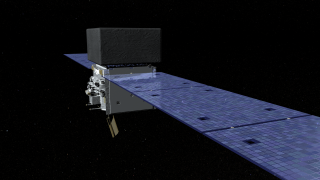|
|
 |
GLAST's LAT Instrument
|
The Large Area Telescope (LAT) detects gamma rays by using Einstein's famous equation (E=mc(squared)) in a technique known as pair production. When a gamma ray, which is pure energy, slams into a layer of tungsten in one of the Tracker's towers, it can create a pair of subatomic particles (an electron and its antimatter counterpart, a positron). The direction of the incoming gamma ray is determined by projecting the direction of these particles back to their source using several layers of high-precision silicon tracking detectors. A separate detector, called a calorimeter, absorbs and measures the energy of the particles. Working on gamma ray at a time, the LAT will make gamma-ray images of astronomical objects, while also determining the energy for each detected gamma ray.
|
|

|
|
This animation shows a gamma ray (purple) entering a corner tower of the Tracker. After the electron (red) and positron (blue) cascade down the tower, their incoming paths (red/blue) combine to show the original path (purple) of the incoming gamma ray that created them.
Duration: 25.4 seconds
Available formats:
320x180
PNG
215 KB
160x80
PNG
57 KB
80x40
PNG
14 KB
512x288 (30 fps)
MPEG-1
10 MB
1280x720 (30 fps)
MPEG-2
64 MB
1280x720 (29.97 fps)
MPEG-4
18 MB
1280x720
Frames
1280x720 (30 fps)
QUICKTIME
2 GB
How to play our movies
|
|
|
Back to Top
|
|
|
|